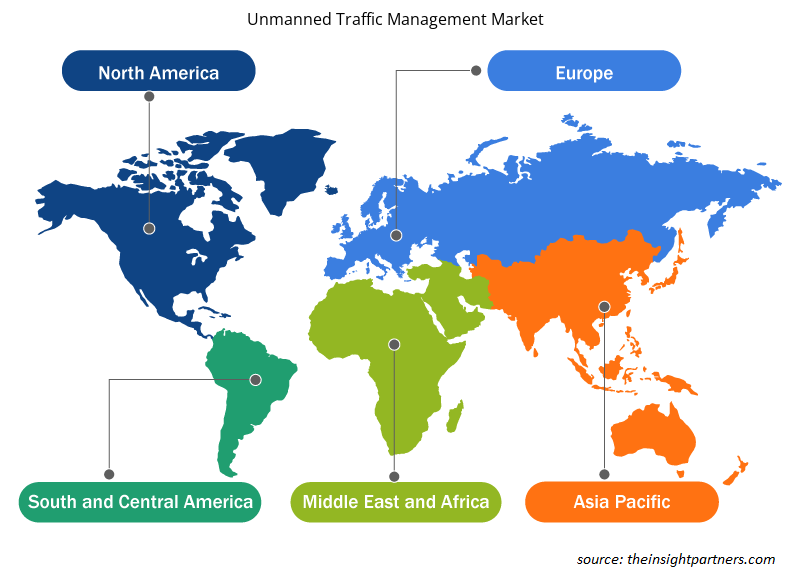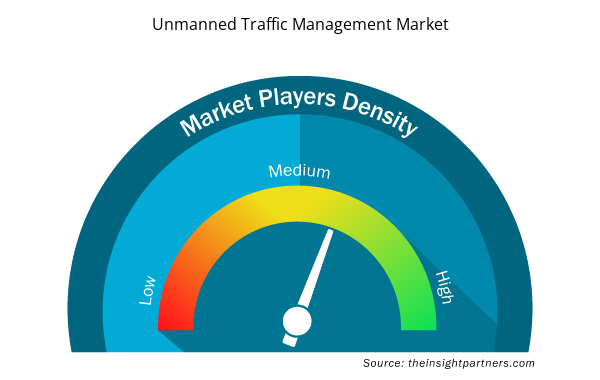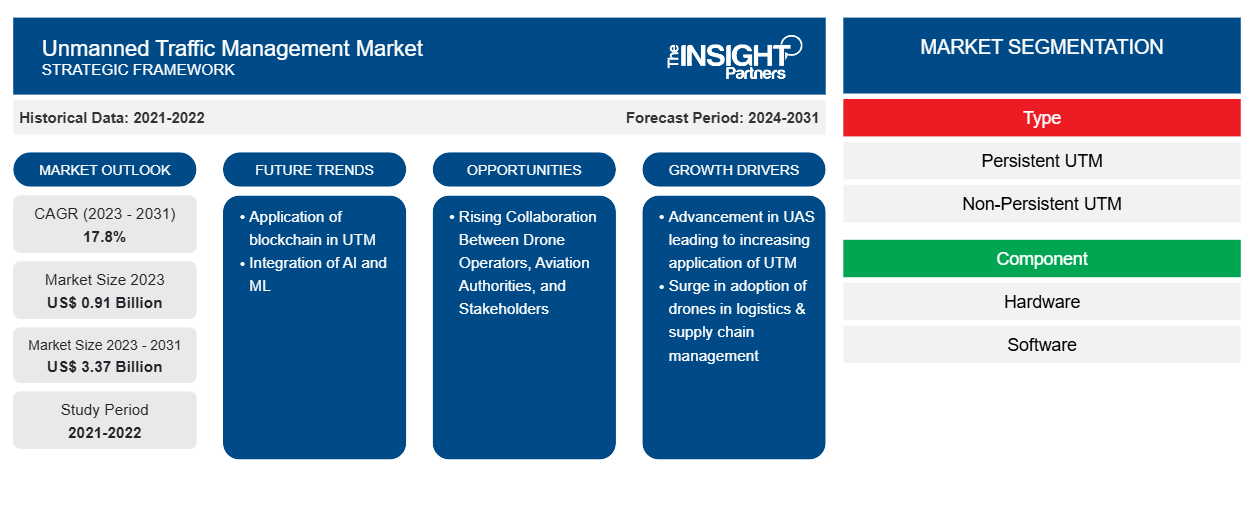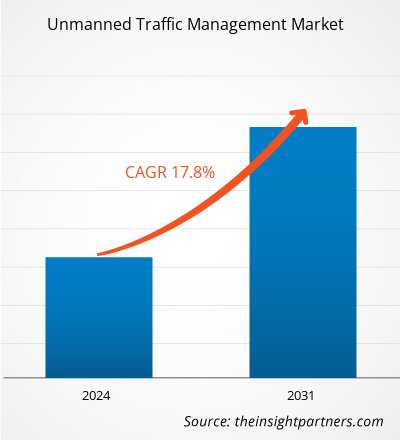無人交通管理市場規模は、2023年の9億1,000万米ドルから2031年には33億7,000万米ドルに達すると予測されています。市場は2023年から2031年の間に17.8%のCAGRを記録すると予想されています。UTMにおけるブロックチェーンの応用の増加は、市場の主要なトレンドであり続けると思われます。
無人交通管理市場分析
無人交通管理ソリューション製品の製造に関する厳格な規制基準は、新規参入者にとって重大な課題です。航空交通を制御するための基準を満たす義務付けられた規制は、市場への新規参入者にとって潜在的な課題を生み出しました。したがって、これは新規参入者が市場に参入するための参入障壁です。したがって、新規参入者の数が少ないほど、既存のプレーヤーは競争の激しい市場で強力な潜在的シェアを維持できます。したがって、これらの要因により、新規参入者に対する脅威は低から中程度になります。
無人交通管理市場の概要
世界の無人交通管理市場のエコシステムの主な利害関係者には、ハードウェアメーカー、ソフトウェア開発者、UTMシステムプロバイダー、および最終用途が含まれます。ハードウェアメーカーは、アンテナ、カメラ、センサーなどのシステムのさまざまなコンポーネントの開発で構成されるシステムメーカーです。世界中でドローンとUASの販売が増加しているため、航空交通量の増加に対する無人交通管理の需要が高まっており、UTMメーカーも持続可能な成長の機会を経験しています。次に、ソフトウェア開発者は、意思決定のためにすべてのデータを収集して視覚化するプラットフォームを提供するソフトウェアを設計します。UTMシステムメーカーは、ソフトウェアとハードウェアを1つのシステムに統合します。主要なUTMシステムプロバイダーには、Lockheed Martin Corp、Thales SA、Frequentis AG、Airbus SE、Raytheon Technologies Corp(Collins Aerospace Systems)などがあります。これらのUTMプロバイダーは、適切な機能のために無人交通管理の進歩に常に取り組んでいます。無人交通管理市場の主な最終用途には、軍事および商業航空オペレーターが含まれます。
要件に合わせてレポートをカスタマイズする
このレポートの一部、国レベルの分析、Excelデータパックなど、あらゆるレポートを無料でカスタマイズできます。また、スタートアップや大学向けのお得なオファーや割引もご利用いただけます。
- このレポートの主要な市場動向を入手してください。この無料サンプルには、市場動向から見積もりや予測に至るまでのデータ分析が含まれます。
無人交通管理市場の推進要因と機会
物流とサプライチェーン管理におけるドローン導入の急増
サプライ チェーン管理 (SCM) は、ほとんどのビジネスにとって重要な側面であり、企業の機能に直接的または間接的に影響を与える可能性があります。インダストリー 4.0 の採用が増加し、あらゆるビジネス分野でモノのインターネット (IoT) 対応デバイスの統合が進むにつれて、SCM でもテクノロジの統合が進んでいます。テクノロジの採用にはさまざまな影響がありますが、ほとんどの場合、そのメリットが課題を上回ります。メリットには、効率性の向上、運用コストの削減、データの安全性などがあります。テクノロジの採用が増えるにつれて、UAV と UAS テクノロジは、そのメリットにより、運輸および物流業界で注目を集めるようになっています。ドローンは、在庫管理、「紛失」商品の追跡、倉庫間の商品移動、ラスト マイルの配送など、サプライ チェーンのさまざまなポイントで活用されています。比較的新しいドローンの用途には、マルチ UAV 並列配送と呼ばれるトラック ドローン コラボレーションがあり、ドローンが配送トラックから直接複数の目的地に配送を実行します。数百マイルにわたって大きな重量物を運ぶことができる貨物用UAVの開発は、この業界でのドローンの採用をさらに促進します。2022年7月、Amazon.com, Inc.は、2022年末までにテキサス州カレッジステーションでドローンを使用して顧客に荷物を配達する計画を発表しました。同社は2022年6月、北カリフォルニアの町ロックフォードでドローンを使用していくつかの荷物を配達する計画を発表しました。このような開発は、無人交通管理市場の成長を後押ししています。
ドローンオペレーター、航空当局、利害関係者間の連携の強化
ドローン事業者は、主にその利点を理由に無人航空機の普及を推進してきました。しかし、航空当局はそのような航空機の運用方法と場所については慎重でした。研究機関と研究所は、両者と協力して UTM を開発してきました。UTM のさまざまな関係者間の連携が強化されれば、ドローンと UAV のより迅速かつ安全な商用利用が保証されます。これに対する理解が深まるにつれ、すべての関係者が定期的に協力して規制を調和させ、VLOS および BVLOS でのドローンの運用に関する規制枠組みを開発してきました。
無人交通管理市場レポートのセグメンテーション分析
無人交通管理市場分析の導出に貢献した主要なセグメントは、タイプ、コンポーネント、アプリケーション、およびエンドユーザーです。
- 無人交通管理市場は、タイプ別に見ると、持続型 UTM と非持続型 UTM に分かれています。持続型 UTM セグメントは 2023 年に市場シェアを拡大しました。
- コンポーネントに基づいて、無人交通管理市場はハードウェアとソフトウェアに分かれています。ハードウェアセグメントは2023年に大きな市場シェアを占めました。
- アプリケーションに基づいて、無人交通管理市場は、通信、ナビゲーション、監視およびモニタリング、その他に分類されます。通信セグメントは、2023年に大きな市場シェアを占めました。
- エンドユーザーに基づいて、無人交通管理市場は、農業と林業、物流と輸送、監視、その他に分類されます。防衛と法執行部門は、2023年に大きな市場シェアを占めました。
無人交通管理市場シェアの地域別分析
無人交通管理市場レポートの地理的範囲は、主に北米、ヨーロッパ、アジア太平洋、その他の地域の 4 つの地域に分かれています。
2023年には北米が市場を支配し、ヨーロッパとアジア太平洋地域がそれに続きます。さらに、アジア太平洋地域も今後数年間で最高のCAGRを記録する可能性があります。米国は2023年に北米の無人交通管理市場を支配しました。無人交通管理市場は、フロリダ、アイダホ、ミネソタ、サウスダコタでドローンの使用に関する11種類の法律を制定し、山火事管理を含む緊急管理作業員にドローンを使用することを許可するなど、政府の支援的な規制により、米国で成長すると予想されています。また、アイダホ州とミネソタ州は、交通事故の再現、捜索救助任務、訓練目的など、特定の目的で法執行機関が無人航空機システム(ドローン)を運用することを許可しました。米国の州は、さまざまな用途で社会の改善のためにドローンを飛行させるための規制を策定しました。したがって、ドローンの今後の規制により、空中の無人車両の数が増加し、交通管理システムの需要が市場の成長を促進すると予想されます。さらに、政府の支援的な資金提供イニシアチブも、この国の市場成長にさらに貢献しています。たとえば、2021年3月、米国空軍のAgility Primeイニシアチブは、「Air Race to Certification」プログラムに参加する約20種類のeVTOL航空機の飛行テストと認証の取り組みに資金を提供します。Agility Primeイニシアチブは、短期的なeVTOL研究開発(R&D)作業に従事する中小企業、大学、その他の非営利研究機関の257チームにも資金を提供しています。このように、このようなイニシアチブは無人航空機の採用を加速させ、市場の成長を推進しています。
無人交通管理市場の地域別分析
予測期間を通じて無人交通管理市場に影響を与える地域的な傾向と要因は、Insight Partners のアナリストによって徹底的に説明されています。このセクションでは、北米、ヨーロッパ、アジア太平洋、中東、アフリカ、南米、中米にわたる無人交通管理市場のセグメントと地理についても説明します。

- 無人交通管理市場の地域別データを入手
無人交通管理市場レポートの範囲
| レポート属性 | 詳細 |
|---|---|
| 2023年の市場規模 | 9億1千万米ドル |
| 2031年までの市場規模 | 33億7千万米ドル |
| 世界のCAGR(2023年~2031年) | 17.8% |
| 履歴データ | 2021-2022 |
| 予測期間 | 2024-2031 |
| 対象セグメント | タイプ別
|
| 対象地域と国 | 北米
|
| 市場リーダーと主要企業プロフィール |
|
無人交通管理市場のプレーヤー密度:ビジネスダイナミクスへの影響を理解する
無人交通管理市場は、消費者の嗜好の変化、技術の進歩、製品の利点に対する認識の高まりなどの要因により、エンドユーザーの需要が高まり、急速に成長しています。需要が高まるにつれて、企業は提供を拡大し、消費者のニーズを満たすために革新し、新たなトレンドを活用し、市場の成長をさらに促進しています。
市場プレーヤー密度とは、特定の市場または業界内で活動している企業または会社の分布を指します。これは、特定の市場スペースに、その規模または総市場価値と比較して、どれだけの競合相手 (市場プレーヤー) が存在するかを示します。
無人交通管理市場で事業を展開している主要企業は次のとおりです。
- ロッキード・マーティン社
- レオナルド SpA
- タレスグループ
- レイセオンテクノロジーズ株式会社
- アルティテュードエンジェル株式会社
- フリークエンティスAG
免責事項:上記の企業は、特定の順序でランク付けされていません。

- 無人交通管理市場のトップキープレーヤーの概要を入手
無人交通管理市場のニュースと最近の動向
無人交通管理市場は、主要な企業出版物、協会データ、データベースなどの一次調査と二次調査後の定性的および定量的データを収集することによって評価されます。無人交通管理市場の動向のいくつかを以下に示します。
- タレスとタイコムは、アジアを代表する衛星通信事業者であり統合衛星通信プロバイダーであるタイコムの子会社を通じて、タイのドローンエコシステムの成長を可能にする無人交通管理(UTM)フレームワークの基盤を確立しました。(出典:タレス、プレスリリース、2024年4月)
- CAL Analytics は、オハイオ州運輸局 (ODOT) と連携して、州全体の運用をサポートするためにドローン用の低高度航空交通管理システムを導入しました。(出典: CAL Analytics、プレスリリース、2024 年 3 月)
無人交通管理市場レポートの対象範囲と成果物
「無人交通管理市場の規模と予測(2021〜2031年)」レポートでは、以下の分野をカバーする市場の詳細な分析を提供しています。
- 対象範囲に含まれるすべての主要市場セグメントについて、世界、地域、国レベルでの無人交通管理市場の規模と予測
- 無人交通管理市場の動向、およびドライバー、制約、主要な機会などの市場動向
- ポーターの5つの力の詳細な分析
- 主要な市場動向、世界および地域の枠組み、主要プレーヤー、規制、最近の市場動向を網羅した無人交通管理市場分析
- 市場集中、ヒートマップ分析、主要プレーヤー、無人交通管理市場の最近の動向を網羅した業界展望と競争分析
- 詳細な企業プロフィール
- 過去2年間の分析、基準年、CAGRによる予測(7年間)
- PEST分析とSWOT分析
- 市場規模価値/数量 - 世界、地域、国
- 業界と競争環境
- Excel データセット



Report Coverage
Revenue forecast, Company Analysis, Industry landscape, Growth factors, and Trends

Segment Covered
This text is related
to segments covered.

Regional Scope
North America, Europe, Asia Pacific, Middle East & Africa, South & Central America

Country Scope
This text is related
to country scope.
よくある質問
North America region dominated the unmanned traffic management market in 2023.
Advancement in UAS leading to increasing application of UTM and surge in adoption of drones in logistics & supply chain management are some of the factors driving the growth for unmanned traffic management market.
Application of blockchain in UTM is one of the major trends of the market.
Lockheed Martin Corporation, Leonardo SpA, Thales Group, Raytheon Technologies Corporation, Altitude Angel Ltd, Frequentis AG, AirMap Inc, Unify NV, Onesky Systems Inc, and Airbus SA are some of the key players profiled under the report.
The estimated value of the unmanned traffic management market by 2031 would be around US$ 3.37 billion.
The unmanned traffic management market is likely to register of 17.8% during 2023-2031.
Trends and growth analysis reports related to Aerospace and Defense : READ MORE..
The Insight Partners performs research in 4 major stages: Data Collection & Secondary Research, Primary Research, Data Analysis and Data Triangulation & Final Review.
- Data Collection and Secondary Research:
As a market research and consulting firm operating from a decade, we have published and advised several client across the globe. First step for any study will start with an assessment of currently available data and insights from existing reports. Further, historical and current market information is collected from Investor Presentations, Annual Reports, SEC Filings, etc., and other information related to company’s performance and market positioning are gathered from Paid Databases (Factiva, Hoovers, and Reuters) and various other publications available in public domain.
Several associations trade associates, technical forums, institutes, societies and organization are accessed to gain technical as well as market related insights through their publications such as research papers, blogs and press releases related to the studies are referred to get cues about the market. Further, white papers, journals, magazines, and other news articles published in last 3 years are scrutinized and analyzed to understand the current market trends.
- Primary Research:
The primarily interview analysis comprise of data obtained from industry participants interview and answers to survey questions gathered by in-house primary team.
For primary research, interviews are conducted with industry experts/CEOs/Marketing Managers/VPs/Subject Matter Experts from both demand and supply side to get a 360-degree view of the market. The primary team conducts several interviews based on the complexity of the markets to understand the various market trends and dynamics which makes research more credible and precise.
A typical research interview fulfils the following functions:
- Provides first-hand information on the market size, market trends, growth trends, competitive landscape, and outlook
- Validates and strengthens in-house secondary research findings
- Develops the analysis team’s expertise and market understanding
Primary research involves email interactions and telephone interviews for each market, category, segment, and sub-segment across geographies. The participants who typically take part in such a process include, but are not limited to:
- Industry participants: VPs, business development managers, market intelligence managers and national sales managers
- Outside experts: Valuation experts, research analysts and key opinion leaders specializing in the electronics and semiconductor industry.
Below is the breakup of our primary respondents by company, designation, and region:

Once we receive the confirmation from primary research sources or primary respondents, we finalize the base year market estimation and forecast the data as per the macroeconomic and microeconomic factors assessed during data collection.
- Data Analysis:
Once data is validated through both secondary as well as primary respondents, we finalize the market estimations by hypothesis formulation and factor analysis at regional and country level.
- Macro-Economic Factor Analysis:
We analyse macroeconomic indicators such the gross domestic product (GDP), increase in the demand for goods and services across industries, technological advancement, regional economic growth, governmental policies, the influence of COVID-19, PEST analysis, and other aspects. This analysis aids in setting benchmarks for various nations/regions and approximating market splits. Additionally, the general trend of the aforementioned components aid in determining the market's development possibilities.
- Country Level Data:
Various factors that are especially aligned to the country are taken into account to determine the market size for a certain area and country, including the presence of vendors, such as headquarters and offices, the country's GDP, demand patterns, and industry growth. To comprehend the market dynamics for the nation, a number of growth variables, inhibitors, application areas, and current market trends are researched. The aforementioned elements aid in determining the country's overall market's growth potential.
- Company Profile:
The “Table of Contents” is formulated by listing and analyzing more than 25 - 30 companies operating in the market ecosystem across geographies. However, we profile only 10 companies as a standard practice in our syndicate reports. These 10 companies comprise leading, emerging, and regional players. Nonetheless, our analysis is not restricted to the 10 listed companies, we also analyze other companies present in the market to develop a holistic view and understand the prevailing trends. The “Company Profiles” section in the report covers key facts, business description, products & services, financial information, SWOT analysis, and key developments. The financial information presented is extracted from the annual reports and official documents of the publicly listed companies. Upon collecting the information for the sections of respective companies, we verify them via various primary sources and then compile the data in respective company profiles. The company level information helps us in deriving the base number as well as in forecasting the market size.
- Developing Base Number:
Aggregation of sales statistics (2020-2022) and macro-economic factor, and other secondary and primary research insights are utilized to arrive at base number and related market shares for 2022. The data gaps are identified in this step and relevant market data is analyzed, collected from paid primary interviews or databases. On finalizing the base year market size, forecasts are developed on the basis of macro-economic, industry and market growth factors and company level analysis.
- Data Triangulation and Final Review:
The market findings and base year market size calculations are validated from supply as well as demand side. Demand side validations are based on macro-economic factor analysis and benchmarks for respective regions and countries. In case of supply side validations, revenues of major companies are estimated (in case not available) based on industry benchmark, approximate number of employees, product portfolio, and primary interviews revenues are gathered. Further revenue from target product/service segment is assessed to avoid overshooting of market statistics. In case of heavy deviations between supply and demand side values, all thes steps are repeated to achieve synchronization.
We follow an iterative model, wherein we share our research findings with Subject Matter Experts (SME’s) and Key Opinion Leaders (KOLs) until consensus view of the market is not formulated – this model negates any drastic deviation in the opinions of experts. Only validated and universally acceptable research findings are quoted in our reports.
We have important check points that we use to validate our research findings – which we call – data triangulation, where we validate the information, we generate from secondary sources with primary interviews and then we re-validate with our internal data bases and Subject matter experts. This comprehensive model enables us to deliver high quality, reliable data in shortest possible time.


 このレポートの無料サンプルを入手する
このレポートの無料サンプルを入手する